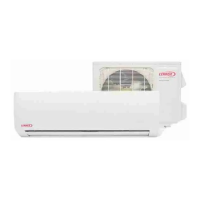Theventoutletmustbeinstalledinalocationthatprevents
buildingdegradationand must be consistentwith the
NationalFuelGasCode,Z223.1orCAN/CGA-B149,1&.2,
In addition to the above requirements, consideration must
be given to prevent unwanted ice build-up from the vent
condensate. The vent should not be located on the side of a
building where the prevailing winter winds could trap the
moisture causing it to freeze on the walls or on overhangs
(under eaves), The vent location should not discharge over
a sidewalk, patio or other walkway, where the condensate
could cause the surface to become slippery,
The products of combustion must not be allowed to
accumulate within a confined space and recirculate,
Units are shipped with the compressor mountings
factory-adjusted and ready for operation.
Proper sizing of gas piping depends on the cubic feet per
hour of gas flow required, specific gravity of the gas and
length of run, The current National Fuel Gas Code Z223,1
should be followed in all cases unless superseded by local
codes or gas company requirements, Refer to tables 2 and
3, In Canada see CAN/CGA B,149,1 & ,2 (latest edition),
Table 2
Gas Heat Application Data
Input Rating Output Rating Gas Capaci_
(Btu) (Btu) (FT3 / HR)
50,000 40,000 47
75,000 60,000 70
100,000 80,000 93
125,000 100,000 116
Before connecting piping, check with gas company or
authorities having jurisdiction for local codes or require-
ments. When installing gas supply piping, length of run
from gas meter must be considered in determining pipe
size for 0,5 inch w.c, maximum pressure drop. Do not
use supply pipe smaller than unit gas connection, For
natural gas unit, operating pressure at the unit gas con-
nection must be a minimum of 4.5 inch w.c. and a maxi-
mum of 13,5 w.c. For propane/LP gas units, operating
pressure at the unit gas connection must be a minimum
of 11 inches w.c. and a maximum of 13,5 inches w.c,
Table 3
Gas Pipe Capacity-FT 3 / HR
Nominal Iron Pipe Size (inches)
Length in Feet
1_ in.
10 132
20 92
30 73
40 63
50 56
60 50
70 46
80 43
90 40
100 38
3/4 in. 1 in. 1-1/4 in.
278 520 1050
190 350 730
152 285 590
130 245 500
115 215 440
105 195 400
96 180 370
90 170 350
84 160 320
79 150 305
When making piping connections, a drip leg should be
installed on vertical runs to serve as a trap for sediment or
condensate, A 1/8 inch N,RT. tap accessible for test gauge
connection must be provided in field piping upstream from
gas supply connection to unit. Install a ground joint union
between gas control manifold and the manual main shut-
off valve. See figure 5,
Compounds used on threaded joints of gas piping shall be
resistant to the action of propane/LP gases.
Drip Leg Installation
field provided
1/8 in. p
ground joint
union
manual main
shut-off
base of unit
leg support
piping
support
Figure 5
Pressure Test Gas Piping
When pressure testing gas lines, the gas valve must be dis-
connected and isolated. Gas valve can be damaged if sub-
jected to more than 0,5 psig (14 inch w.c.), See figure 6,
If test pressure is equal to or less than 0,5 psig (14 inch
w.c.) shutoff the manual main shut-off valve before pres-
sure testing to isolate unit from gas supply system.
Page 7

